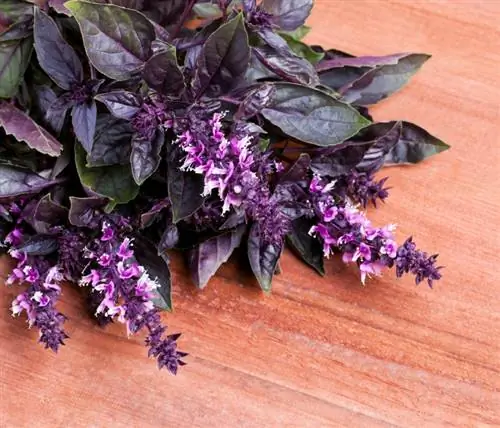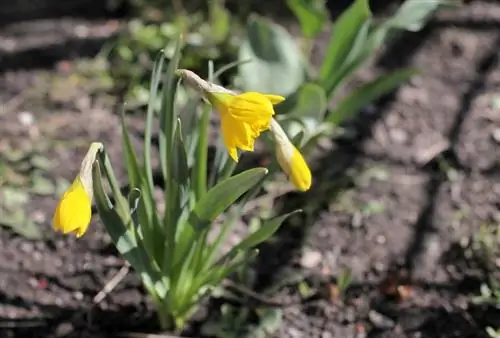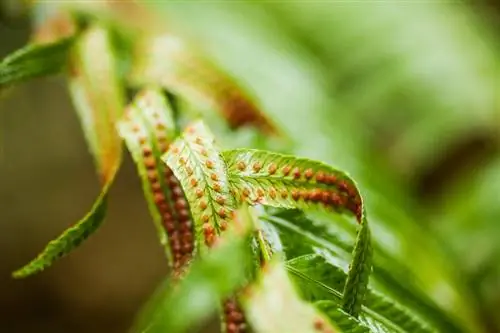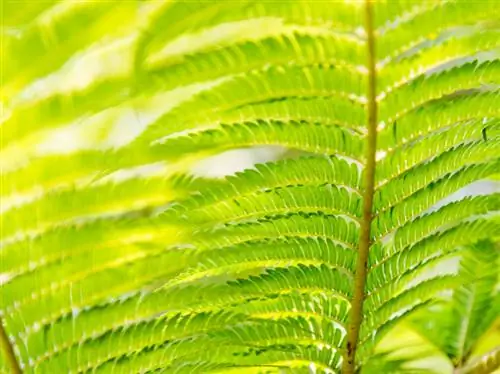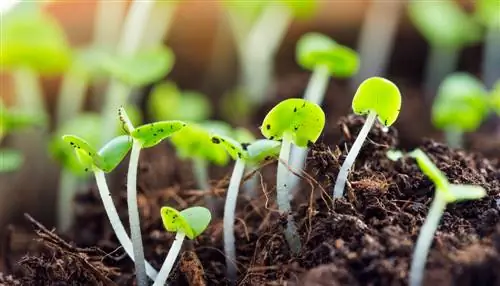- Author admin [email protected].
- Public 2023-12-16 16:46.
- Last modified 2025-06-01 06:02.
Basil produces its first flowers as early as July. Contrary to popular belief, kingweed does not become poisonous. Instead, hobby gardeners now have a variety of options to choose from. You can find out what these are here.
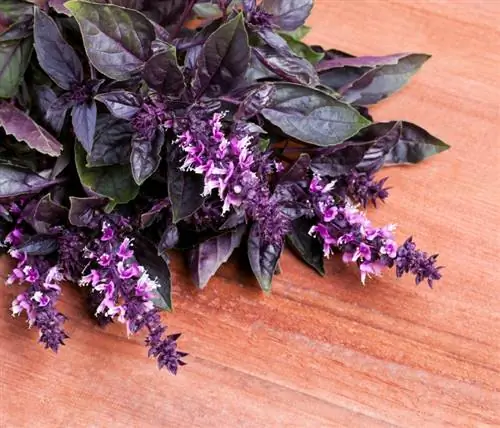
What happens when basil blooms and how can I prevent it?
When basil flowers, it does not become poisonous, but the aroma of the leaves may be affected. To prevent or delay flowering, you should harvest basil regularly and cut off shoot tips. The flowers themselves are edible and can be used for decoration or in basil flower vinegar.
How to prevent flowering for long herbal enjoyment
With its flowers, the herb plant attracts busy insects as pollinators. In this way, basil pursues its central goal of multiplying as numerously as possible. Only pollinated flowers can develop into seeds, which, after germination, turn into new plants. Therefore, the royal herb invests all of its energy in the flower, at the expense of the aroma in the leaves.
Since flowering basil simultaneously stops growing and gradually dies, experienced herb lovers consistently counteract this process. The following measures will prevent or at least delay flowering:
- Harvest basil regularly
- don't pluck individual leaves, but rather 5 centimeter long pieces of shoots
- leafless shoots die hopelessly
- When cutting entire branches, leave at least 2 eyes on them
Harvest when the first buds appear at the latest. Cutting the shoot tips also contributes to further branching and a bushy habit. Whatever is not used fresh in the kitchen can be frozen or dried. Blooming basil is still edible, but tastes unpleasantly bitter. By harvesting the branches in a timely manner, experienced hobby gardeners preserve the wonderful aroma.
Blooming basil - this is how you enjoy the flowers
As a mint family, flowering basil is a feast for the eyes in the bed and on the balcony. Depending on the variety, white, pink or purple flowers develop. As if that weren't enough, the flowers are edible. Since their taste strikes the tongue as slightly bitter and less aromatic than the leaves, gourmets use basil flowers to decorate salads or to garnish warm dishes.
In addition, flowering basil offers a delicious variant for the kitchen, as it provides the most important ingredient for the unique basil flower vinegar. To do this, place 80 flowers in 200 milliliters of white wine vinegar and add 15 leaves of royal herb and peppercorns to taste. After four weeks, strain through a fine sieve and pour into a bottle - done.
Let basil bloom - this is how you harvest the seeds
If you can't get enough of the enchanting flowers of the royal herb, let nature take its course. Flowering basil develops rich seed heads over the course of autumn, which are ideal for propagation by sowing. After all the flowers have withered, the 1-2 millimeter small fruits ripen inside the calyx. First pick off the withered leaves. Then harvest the seeds like this:
- strip off the dried flowers with your fingers over a bowl
- grate the flowers between your hands
- sift the mixture of flower residues and seeds repeatedly
- pour the black seeds onto a plate and let them dry for a few days
The harvested seeds should be stored safely in a dark screw-top jar in the cool cellar until sowing next spring.
How to sow successfully
In April, the time window opens for sowing the seeds you collected yourself, which a flowering basil produced the previous year. Since royal herb cannot tolerate temperatures below 10 degrees, the only option is to sow behind glass. Basil should not be planted outside before mid-May. This is how you sow royal herb correctly:
- fill small cultivation pots with peat sand, seed soil or similar lean, permeable substrate
- slightly moisten the soil and sprinkle the fine seeds on it
- as a light germinator, simply press the seeds lightly with a board
- Wait for germination in a partially shaded location at 20 to 25 degrees Celsius
The cotyledons emerge from the seeds within 5 to 14 days. Any cover has now done its job. When the seedlings have reached a height of 5 centimeters, they are pricked out. Now pamper your pupils for the first time with a highly diluted dose of liquid fertilizer. By mid-May they develop into strong young plants that can be planted out in beds or pots.
Tips & Tricks
On perennial basil varieties, the flowering does not affect the aroma of the leaves. In this case, flowering basil does not stop growing and does not develop seed heads. You can enjoy the pink and purple flowers and harvest rich shoots at the same time. It is also possible to spend the winter indoors.

